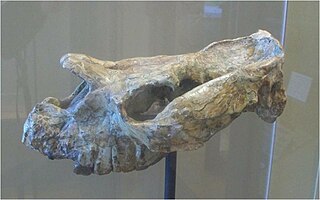
Xenungulata is an order of extinct and primitive South American hoofed mammals that lived from the Late Paleocene to Early Eocene. Fossils of the order are known from deposits in Brazil, Argentina, Peru, and Colombia. The best known member of this enigmatic order is the genus Carodnia, a tapir-like and -sized animal with a gait similar to living African elephants.

Astrapotheria is an extinct order of South American and Antarctic hoofed mammals that existed from the late Paleocene to the Middle Miocene, 59 to 11.8 million years ago. Astrapotheres were large, rhinoceros-like animals and have been called one of the most bizarre orders of mammals with an enigmatic evolutionary history.

Leontiniidae is an extinct family comprising eighteen genera of notoungulate mammals known from the Middle Eocene (Mustersan) to Late Miocene (Huayquerian) of South America.
Henricosborniidae is a family of extinct notoungulate mammals known from the Late Paleocene to Middle Eocene of Argentina, Bolivia and Brazil. The name honors U.S. paleontologist Henry Fairfield Osborn.
The South American land mammal ages (SALMA) establish a geologic timescale for prehistoric South American fauna beginning 64.5 Ma during the Paleocene and continuing through to the Late Pleistocene. These periods are referred to as ages, stages, or intervals and were established using geographic place names where fossil materials where obtained.

The Itaboraian age is a period within the Early Eocene geologic time epoch of the Paleogene, used more specifically with South American land mammal ages (SALMA). It follows the Riochican and precedes the Casamayoran age.
The Casamayoran age is a period of geologic time within the Early Eocene epoch of the Paleogene, used more specifically within the South American land mammal age (SALMA) classification. It follows the Itaboraian and precedes the Mustersan age.

Astrapotheriidae is an extinct family of herbivorous South American land mammals that lived from the Late Eocene to the Middle Miocene 37.71 to 15.98 million years ago. The most derived of the astrapotherians, they were also the largest and most specialized mammals in the Tertiary of South America. There are two sister taxa: Eoastrapostylopidae and Trigonostylopidae.
Scaglia is an extinct genus of South American astrapotherid land mammal that lived during the Eocene.

Didolodontidae is a possibly paraphyletic family of "condylarth" mammals known from the Paleogene of South America, with most specimens known from Argentina. They were generally small-medium in body size, and had a bunodont dentition. A close relationship with litopterns has been suggested by some studies. They range in age from the early Paleocene (Selandian/Peligran) to late Eocene (Priabonian/Mustersan). The attribution of Salladolodus deuterotheroides from the Late Oligocene of Bolivia to the family is doubtful.

Astraponotus is an extinct genus of astrapotheriids. It lived during the Middle-Late Eocene and its fossil remains have been found in the Sarmiento Formation of Argentina, South America.
Salta Basin or Salta Rift Basin is a sedimentary basin located in the Argentine Northwest. The basin started to accumulate sediments in the Early Cretaceous (Neocomian) and at present it has sedimentary deposits reaching thicknesses of 5,000 metres (16,000 ft). The basin contains seven sub-basins: Tres Cruces, Lomas de Olmedo, Metán, Alemanía, Salfity, El Rey, Sey and Brealito. The basin environment has variously been described as a "foreland rift" and an "intra-continental rift". The basin developed under conditions of extensional tectonics and rift-associated volcanism.
Utaetus is an extinct genus of mammal in the order Cingulata, related to the modern armadillos. The genus contains two species, Utaetus buccatus and U. magnum. It lived in the Late Paleocene to Late Eocene and its fossil remains were found in Argentina and Brazil in South America.
The Geste Formation is a fossiliferous geologic formation of the Puna Plateau in the western Salta Province and northern Catamarca Province of the Argentine Northwest, northwestern Argentina.
Simpsonotus is an extinct genus of notoungulate mammals in the family Henricosborniidae from the Middle to Late Paleocene of South America. Fossils of the genus have been found in the Mealla Formation, a fluvial and lacustrine sedimentary unit of the Salta Basin in northwestern Argentina. The genus name honors paleontologist George Gaylord Simpson.
Saltaodus is an extinct genus of mammals, belonging to the family Didolodontidae. It lived during the Late Eocene, in what is now South America.

Isotemnus is an extinct genus of notoungulate belonging to the family Isotemnidae. It lived from the Late Paleocene to the Middle Eocene of what is now Argentina.
Coquenia is an extinct genus of Notoungulate, belonging to the family Leontiniidae. It lived during the Middle Eocene, in what is today Argentina.
Colbertia is an extinct genus of oldfieldthomasiid notoungulate. It lived from the Early to the Middle Eocene, and its fossilized remains were discovered in Argentina and Brazil.
Eucinepeltus is an extinct genus of glyptodont. It lived during the Early Miocene, and its fossilized remains were discovered in South America.
















